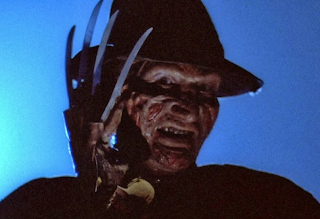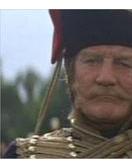 Credit A Nightmare for Elm Street (1984) with one of the more inventive horror premises. In many ways, Wes Craven's signature movie is a standard issue slasher, but scores in its neat story and nasty villain.
Credit A Nightmare for Elm Street (1984) with one of the more inventive horror premises. In many ways, Wes Craven's signature movie is a standard issue slasher, but scores in its neat story and nasty villain.Teenagers in a small Ohio town start experiencing horrifying dreams involving a fedora- and sweater-wearing creep with a bladed gloves. Nobody thinks much of it until the teens wake up dead from impossible injuries. Nancy (Heather Langenkamp), one of the survivors, discovers that their tormentor is Freddy Krueger (Robert Englund), a serial killer who was murdered by a mob of victim's parents. Ignoring her skeptical parents, Nancy determines to take out Freddy however she can.
By 1984, the slasher tropes established by Black Christmas and Halloween were basically etched in stone. Craven dutifully checks off the expected tropes: the teenage victims, disbelieving parents, victims punished for having sex, and buckets and buckets of blood. I guess that's my big hurdle with these movies: unless mated to a good story or a standout style, the hack-and-slash bloodletting of slasher flicks gets old pretty fast. Even Nightmare's signature scene, where a bed swallows a victim and erupts in a fountain of blood, is so absurdly gross that it moved me to laughter.
Still, Nightmare benefits immensely from the creative set-up. Craven's imaginative effects - Krueger's bendy arms and self-mutilation, a monster pressing slowly through a solid wall, a phone that develops a tongue at an inopportune moment - mix with black humor. Nightmare explores the line between imagination and reality, a key dividing line between childhood and adulthood that the movie stomps all over (one of the most unsettling moments has Nancy become prematurely gray after a nightmare). But really, there's something intrinsically terrifying in dreams becoming real, even if for most of us, they concern regressing to high school rather than murder by an immortal serial killer.
It helps, too, that Nightmare makes that killer unusually magnetic. Robert Englund's Freddy is easily the most personable of the franchise slashers. He's not likable, exactly, but he has a strong personality and a macabre sense of humor that makes his antics more fun to watch than Michael Myers or Jason Voorhes. The sequels play up his penchant for quips to an absurd level, but here Englund makes him the right mixture of funny and frightening. Really though, after so many movies with a nameless, motiveless brute massacring horny teens, it's nice to see one who talks.
Heather Langenkamp is solid in the "final girl" role, credibly transitioning from ordinary teen to tough woman. With her parents (John Saxon and Ron Blakley, more engaged than the material demands) refusing to believe her, she's forced to mature in an awful hurry, becoming self-sufficient enough to stop a supernatural killer. The other teen actors are mostly adequate, including a baby-faced Johnny Depp, who meets the most gruesome fate of all.
Wes Craven managed a long and enviable career of cult classics and, occasionally, lamentable dreck. His other big success, Scream (1996), turned the genre's tropes on their heads, which in turn triggered a trend of self-aware, semi-parodic slashers. A Nightmare on Elm Street wears its ordinariness on its sleeve, rearranging the tropes just enough to make for a memorable show.

